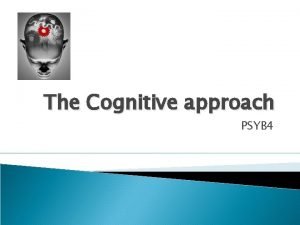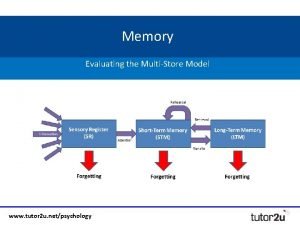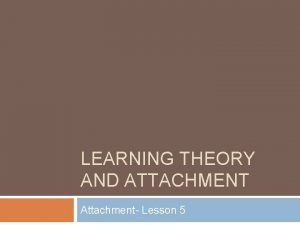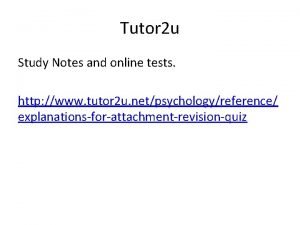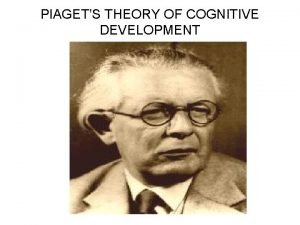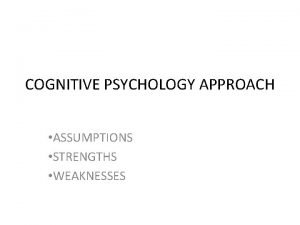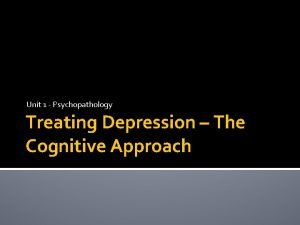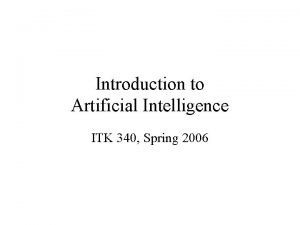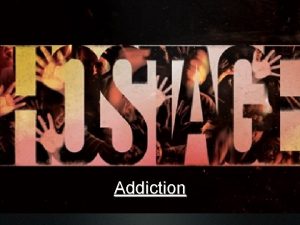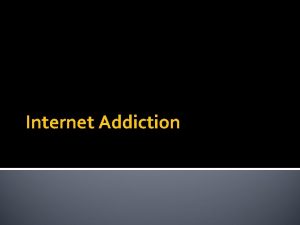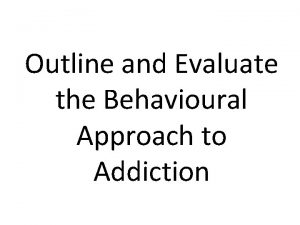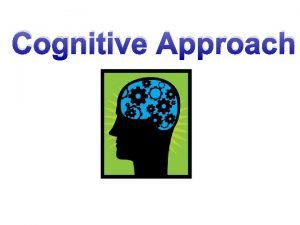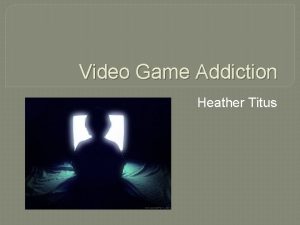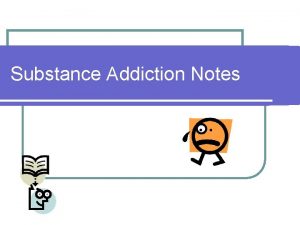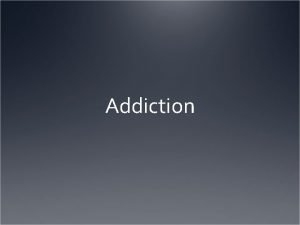Cognitive Approach to Addiction Outline Evaluate the Cognitive
















- Slides: 16

Cognitive Approach to Addiction Outline & Evaluate the Cognitive Approach (& Treatment) to Addiction

General Mechanisms • Self Regulation: Weighting up relative importance of relevant factors (incl. personal goal’s) in planning behaviour. • Cognitive Myopia: People consider present & future consequences of actions (Ainslie, 1992), but give them different weighting … • Herrnstein & Prelec (1992): drug use = immediate gratification prioritised over long term consequence • Addictive Beliefs (Beck, 1993): what people THINK about drugs has important role in development of addictive behaviour. Over time (and repeat usage) belief shifts from ‘It would be fun/exciting/etc to try’ to ‘I need. . . To get through the day’ • Tiffany (1990): Over time drug use become regulated by automatic processing triggered by external stimuli (behaviourism connection).

Cognitive Models of Addiction • Three dominant frameworks: 1. Self-medication model 2. Expectancy theory 3. Rational choice theory

Your Task (should you choose to accept it … *shakes head* not really) • To produce notes / revision resource that shows the following: 1. Gives an overview of the cognitive approach. 2. Summarises the key AO 1 information for each of the three models. 3. Summarises the AO 2/3 points covered and add any you feel relevant.

Rational Choice Theory (I) • Becker and Murphy (1998): People choose to engage in an activity as a result of weighing up the costs and benefits. • The theory uses the concept of ‘utility’, which in economics is a measure of the relative satisfaction resulting from consumption of a particular good or service; ‘utility’ = cost – benefit. • Addiction is experienced as an increase in consumption of ‘goods’ (e. g. drugs, alcohol or gambling) because individuals have made a rational choice concerning their current and future ‘utility’ of their drug taking. • Maintenance and Relapse: addicts are rational consumers who look ahead and behave in a way that is likely to maximise the preferences they hold.

Rational Choice Theory (II) • This explains why some addicts can actually just stop. In utility terms when the costs are too high (e. g. life becomes really unpleasant, pregnancy, etc) they do stop • However, there is a monkey wrench in the works! • Rational addiction theory would predict that gamblers, particularly those which lose, should not continue their gambling behaviour. • The study by Griffiths (1994) offers an explanation for this based on the cognitive bias (i. e. irrational thinking) that distorts the reasoning of addictive gamblers. • Such biases as hindsight bias, flexible attributions, erroneous perceptions, and personification (of machines)

Cognitive Bias in Fruit Machine Gambling • Griffiths compared 30 regular gamblers with 30 non regular gamblers and measured their verbalisations as they played a fruit machine. • Regular gamblers believed they were more skilful than they actually were and were more likely to make irrational verbalisations during play (e. g. ‘putting only a quid in bluffs the machine’) they tended to treat the machine as if it were a person (e. g. ‘this fruity is not in a good mood’). • They also explained away their loses by seeing ‘near misses’ as ‘near wins’. Something which justified their continuation (they are nearly winning not losing) = Irrational Thinking

Expectancy Theory • Expectations about the outcomes of addictive behaviour are thought to contribute to their excessive use. Addicts differ from non addicts in terms of their expectations about the positive versus negative effects of these behaviours • Initiation: Heavier drinkers have been shown to have more positive expectations about the effects of alcohol compared to light drinkers (e. g. social and physical pleasure, tension reduction, greater sociability) – e. g. Brown (1985) • Maintenance and relapse: Brandon (2004) - as addiction develops, the activity is influenced less by conscious expectations & more by unconscious expectations. This explains the loss of control many addicts experience, and the difficulties they experience in abstaining (giving it up). • Can prevent relapse by altering the persons expectations consciously thus affecting the unconscious. Tate et al (1994): Smokers experiences fewer somatic and psychological symptoms of withdrawal from smoking when told to not expect any negative effects compared to the control group

COPING: Self Medication model • Initiation: individuals intentionally use the addictive behaviour to cope with –or escape from- stress / psychological problems. • The particular addiction is not chosen at random but has been selected as it is perceived to help a particular problem. • 1. 2. 3. Helps fulfil 3 major functions Mood regulation Performance management Distraction • Maintenance and Relapse: Addiction becomes a psychological crutch; many smokers mention ‘stress relief’ as a major reason why they persist with their habit.

Application of knowledge • Your task to show your understanding is analyse George’s case study in light of the cognitive theories you have studied. • Carry out your analysis in reference to the three models: Self medication model Expectancy theory Rational choice theory Pick the model you think best explains George’s condition & justify your choice.

Cognitive Behavioural Treatment

Intervention - Cognitive Behavioural Therapy • CBT teaches the patient how to recognise and then avoid high risk situations in which they are more likely to use drugs. • Although there a variety of CBTs, when applied to addiction they all share to main component – Functional Analysis: under what circumstances the behaviour occurs. Explores the feelings and motivations before, during and after the event in an attempt to help the patient determine the risk factors. Functional analysis is useful in helping the patient identify possible reasons for the behaviour. – Skills training: teaches the patient better or more appropriate coping strategies. This involves unlearning old habits and replacing them with healthier ones.

Cognitive Behavioural Therapy II • E. g. erroneous beliefs (heuristics) such as an overperception of control and under-estimate of losses help to maintain gambling behaviour. Therapy tests these faulty beliefs and replace them with healthier and realistic ideas. • ‘Cue Exposure’ seeks to disassociate particular cues (environmental, emotional, etc) with addictive behaviour. • ‘Motivational Interviewing’ relies on identifying and mobilizing the client's intrinsic values and goals to resolve ambivalence towards behavioural change (the conflict between indulgence versus restraint)

Cognitive Behavioural Treatment - Effectiveness

Carroll et al (1994) 12 week study comparing effectiveness of drug treatment and CBT to control cocaine addiction. Patients either given the drug desipramine (tricyclic antidepressant) or CBT on how to avoid high-risk situations and develop alternatives to cocaine use. • Both drug and the CBT were effective at treating high level depression (possible cause of the addiction). However, generally the CBT was more effective than the antidepressant in treating cocaine addiction and this was maintained twelve months later. • Carroll et al (and many other researchers in the field) believe that therapy needs to vary from patient to patient. breaks with the ‘one size fits all’ approach of the medical model. Some patients respond better to certain techniques than others.

Morgenstern et al (2001) Compared CBT with Alcoholics Anonymous 12 -step approach; found little difference in effectiveness. • Although it is widely assumed that learning of coping skills is crucial to the success of CBT in treating addiction, some research seems to question this. . . Morgenstern and Longabaugh (2000) • reviewed ten studies in which CBT was compared to other interventions. The link between coping strategies and success was questioned for two reasons: - In nine out of ten studies coping skills improved but this was not reflected in reduced substance abuse or - There was no evidence that CBT was better at teaching coping skills than other psychological therapies.
 Essay on cognitive approach
Essay on cognitive approach Cognitive approach vs behavioral approach
Cognitive approach vs behavioral approach Bandura's reciprocal determinism
Bandura's reciprocal determinism Multi store model evaluation
Multi store model evaluation Learning theory of attachment
Learning theory of attachment Outline and evaluate bowlby's monotropic theory 8 marks
Outline and evaluate bowlby's monotropic theory 8 marks Cognitive and non cognitive religious language
Cognitive and non cognitive religious language Conclusion of piaget's theory
Conclusion of piaget's theory Topic sentence sandwich
Topic sentence sandwich Cognitive approach strengths and weaknesses
Cognitive approach strengths and weaknesses Cognitive approach to treating depression
Cognitive approach to treating depression Personality construct examples
Personality construct examples Reciprocal determinism psychology definition
Reciprocal determinism psychology definition Thinking humanly: the cognitive modeling approach
Thinking humanly: the cognitive modeling approach Datagram switching vs virtual circuit
Datagram switching vs virtual circuit Waterfall vs shower approach
Waterfall vs shower approach Approach approach conflict
Approach approach conflict
